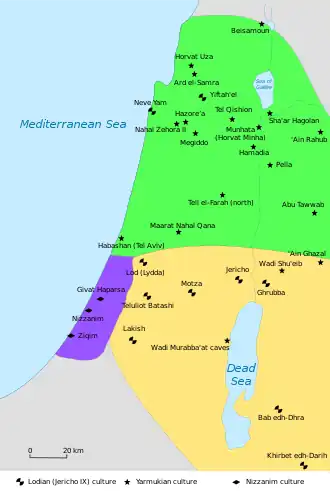Yarmukian culture
The Yarmukian culture was a Pottery Neolithic A (PNA) culture of the ancient Levant. It was the first culture in prehistoric Syria and one of the oldest in the Levant to make use of pottery. The Yarmukian derives its name from the Yarmuk River, which flows near its type site of Sha'ar HaGolan, near Kibbutz Sha'ar HaGolan at the foot of the Golan Heights. This culture existed alongside the Lodian, or Jericho IX culture and the Nizzanim culture to the south.
 Sha'ar HaGolan Map showing the region of Sha'ar HaGolan, type site of the Yarmukian culture. | |
| Geographical range | Levant |
|---|---|
| Period | Neolithic |
| Dates | 6400–6000 BC |
| Type site | Sha'ar HaGolan, Israel |

Recent theory
In 2015, a salvage excavation brought to light a prehistoric site near Beit Hilkia and the Revivim quarry, with findings from the Yarmukian, Late Chalcolithic, and the Middle Bronze Age IIA–IIB.[1] Somewhat surprising was the discovery of a typical Yarmukian-style fired clay figurine of a fertility goddess, the southernmost such finding.[1] Of 163 found up to that date, the vast majority had been discovered in the main area known for its Yarmukian settlements, in and around the northern type-site of Sha'ar Hagolan, with just two exceptions further to the south.[1] This new finding led to speculations that much of the Southern Levant might have been inhabited by a contiguous civilization during the time (c. 6400–6000 BCE), with differences in pottery types being more significant to today's archaeologists than to people living back then.[1]
Related sites

Although the Yarmukian culture occupied limited regions of northern Israel and northern Jordan, Yarmukian pottery has been found elsewhere in the region, including the Habashan Street excavations in Tel Aviv and as far north as Byblos, Lebanon.
Besides the site at Sha'ar HaGolan, by 1999, 20 other Yarmukian sites have been identified in Israel, the West Bank, Jordan and Lebanon.[2] These include, alphabetically:
Israel
- Beisamoun, Hula Valley
- Hazorea (Jezreel Valley, Israel)[3][4]
- HaBashan Street, Tel Aviv, 500 m south of the Yarkon River (Coastal Plain, Israel)[4]
- Hamadiya (central Jordan Valley, Israel)[3][4]
- Munhata (central Jordan Valley, Israel)[3][4]
- Nahal Betzet II settlement (Northern Coastal Plain, Israel)[5]
- Nahal Zehora II settlement (southern Jezreel Valley, Menashe Hills, Israel)[5][6]
- Nahal Zippori 3 settlement (Western Galilee, Israel)[5]
- Tel Kabri (Northern Coastal Plain, Israel)[7]
- Tel Megiddo (Jezreel Valley, Israel) - Yarmukian settlement at the base of the tell[4]
- Tel Qishyon/Qishion/Kishion (wrongly spelled as Tel Kishon by the press) near Mount Tabor (Lower Galilee, Israel)[3][4]
Jordan
- Ain Ghazal (Jordan)[3]
- 'Ain Rahub (Jordan)[3]
- Jebel Abu Thawwab (Jordan)[3]
- Wadi Shueib (Jordan)[3]
West Bank
- Tel Far'ah (North) (Samaria Hills, West Bank)[4]
- Wadi Murabba'at Cave (Judaean desert, West Bank)[4]
- Wadi Qanah Cave (western Samaria Hills, West Bank)[4]
See also
References
- Marmelstein, Yitzhak; van den Brink, Edwin C.M. (26 July 2020). "Bet Hilqiya: Preliminary report". Hadashot Arkheologiyot. Jerusalem: Israel Antiquities Authority. 132. Retrieved 26 May 2021.
- Garfinkel, Y. 1999.
- Yorke M. Rowan, Jonathan Golden, The Chalcolithic Period of the Southern Levant: A Synthetic Review, Journal of World Prehistory, April 2009, 22:1–92, DOI 10.1007/s10963-009-9016-4, accessed 27 December 2019
- Garfinkel, Yosef (1993). "The Yarmukian Culture in Israel". Paléorient. 19 (19–1): 115–134. doi:10.3406/paleo.1993.4587. Retrieved 27 December 2019.
- Vieugué, Julien; Garfinkel, Yosef; Barzilai, Omry; van den Brink, Edwin C. M. (2016). "Pottery function and culinary practices of Yarmukian societies in the late 7th millennium cal. BC: First results". Paléorient. 42 (42–2): 97–115. doi:10.3406/paleo.2016.5722. Retrieved 27 December 2019.
- Avi Gopher and Estelle Orrelle, Preliminary Report on Excavations of Nahal Zehora II — Seasons of 1990 and 1991, Mitekufat Haeven: Journal of the Israel Prehistoric Society, 1991, pp. 169-172, accessed 27 December 2019
- Kempinski, A.; Marder, O.; Prausnitz, M.W.; Khalaily, H.M.; Bankirer, R.Y. (2002). "7". In Scheftelowitz, N.; Oren, R. (eds.). Tel Kabri: The 1986-1993 Excavations Seasons. Tel Aviv: Emery and Claire Yass Publications in Archaeology. p. 305. ISBN 965-266-015-9.
Further reading
- Stekelis M. 1972. The Yarmukian Culture. Jerusalem: Magnes Press.
- Garfinkel Y. 1993. The Yarmukian Culture in Israel. Paléorient, Vol 19, No. 1, pp. 115 – 134.
- Garfinkel Y. 1999. The Yarmukians, Neolithic Art from Sha'ar Hagolan. Jerusalem: Bible Lands Museum (Exhibition Catalogue).
- Garfinkel Y. and Miller M. 2002. Sha'ar Hagolan Vol 1. Neolithic Art in Context. Oxford: Oxbow.
- Garfinkel Y. 2004. The Goddess of Sha'ar Hagolan. Excavations at a Neolithic Site in Israel. Jerusalem: Israel Exploration Society (Hebrew version published in 2002 as: Sha'ar Hagolan. Neolithic Art in the Jordan Valley. Jerusalem: Israel Exploration Society).
- Garfinkel Y. and Ben Shlomo D. In press. Sha'ar Hagolan Vol. 2. Qedem. Jerusalem: Institute of Archaeology, Hebrew University.
- Garfinkel Y., Vered A. and Bar-Yosef O. 2006. The Domestication of Water: The Neolithic Well of Sha'ar Hagolan, Jordan Valley, Israel. Antiquity 80: 686–696.
- Obaidat Daifallah 1995. "Die neolithische Keramik aus Abu Thawwab/Jordanien". Berlin, ex Oriente.
External links
 Media related to Yarmukian Culture at Wikimedia Commons
Media related to Yarmukian Culture at Wikimedia Commons